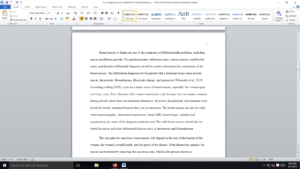Cancerous and noncancerous
approximately 15% of female cancer in the United States is of the breast, second to skin cancer. Discuss when a patient presents to you with a breast mass, what are your differentials? What is your plan of care for a patient who presents with a breast mass, both cancerous and noncancerous?
About one page long.
At least 3 citations, not older than 5 years old.
Requirements: About one page
Answer preview
However, if the disease has not spread, the removal of the cancerous area is enough. Hormonal therapy or endocrine treatment will also be required to prevent any recurrence of the disease, mainly if cancer in the breast ducts (ductal carcinoma in situ) is responsive to estrogen. Some of the most effective medications for endocrine treatment include anastrozole and tamoxifen (Tong et al., 2018). Non-cancerous breast masses are treated using three types of treatments. According to Stachs et al. (2019), one of the treatments is lumpectomy which is a surgery that removes the masses or lumps. Secondly are oral antibiotics,
[480 Words]

Cancerous and noncancerous

